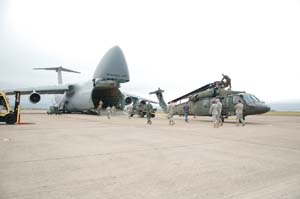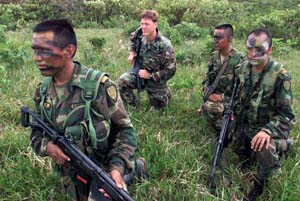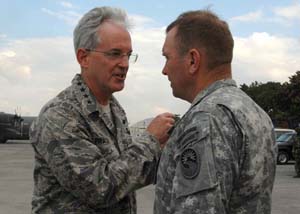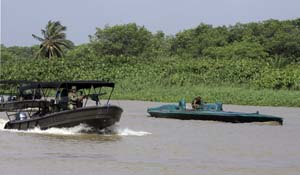Each day, one of the world’s most sophisticated smuggling networks propels contraband toward the United States. Its toxic mixture of illicit drugs, weapons, bulk cash, and criminals spread instability throughout Latin America.
This network feeds the drug cartels that are now challenging the Mexican government and spilling blood and violence along the southern US border. It supplies terrorist insurgencies in Colombia and Peru and well-financed and sophisticated gangs that corrupt fragile governments throughout Central America and the Caribbean. The Defense Department calls this network a direct threat to US national security.
All of which should make Air Force Gen. Douglas M. Fraser, the commander of US Southern Command, a household name. Yet it is one of the vagaries of international relations that US military operations in distant theaters such as Central Command in the Middle East or Pacific Command in Asia typically attract much more media attention than does SOUTHCOM’s daily engagement with America’s neighbors in Central and South America and the Caribbean.
Instability and Insecurity
These nations are increasingly threatened by the illicit network that combines aspects of a regional insurgency, terrorist enterprises, and organized crime.
“Overall the biggest concern I have within the region is not a military threat to the United States, not a conventional military threat to nations within the region; it’s illicit trafficking,” said Fraser at a recent meeting in Washington, D.C. “By illicit trafficking I mean drugs, human trafficking, weapons, bulk cash—all the various, different areas of illicit trafficking, and it affects almost every part of the region,” he said. “My concern [is] the instability, the insecurity that trafficking organizations have brought into different parts of the region,” he said, highlighting Mexico and Colombia as examples.
 |
Soldiers and airmen position a UH-60 Black Hawk helicopter for loading onto a C-5 at Soto Cano AB, Honduras. ( USAF photo by SSgt. Austin M. May) |
SOUTHCOM’s relatively low profile in part reflects regional sensitivities to an overt US military presence in Latin America. As one of 10 unified combatant commands, SOUTHCOM is headquartered in Miami, with two forward operating locations in its area of responsibility at Comalapa, El Salvador, and Aruba/Curacao in the Netherlands Antilles.
In combating the region’s illicit trafficking networks, SOUTHCOM is one of a host of multiagency, multinational players, albeit a very important one. Because 90 percent of the cocaine and 47 percent of the heroin that reaches the US originates in or passes through Colombia, the country remains a central focus of counternarcotics operations in the region.
As part of a narcoterrorism initiative, SOUTHCOM has deployed nearly 400 US personnel to Colombia, where they offer training, logistics, and intelligence support to Colombian security forces battling the Revolutionary Armed Forces (FARC) militia and narcoterrorist group.
“The Colombians have been very successful this year at finding and eliminating some senior FARC leaders, as well as midlevel leaders,” said Fraser, who estimated that the number of FARC insurgents in Colombia has declined by roughly half over the past decade, from 16,000 to roughly 8,000.
As the group has come under pressure, he said, it has reverted back to tactics such as kidnapping and extortion, suggesting that its funding from the drug trade may have been disrupted. Asked about the reasons for recent Colombian success, Fraser points to the country’s determination to build the capacity of their armed forces and law enforcement agencies in order to combat the threat.
“What we have been doing is enabling [Colombia’s] capacity,” he said. “So as they’ve learned how to work and conduct joint operations, we’ve enabled that. We’ve enabled training from riverine capacities to supporting some of their special ops, to supporting aircraft maintenance and those types of things.”
 |
|
Through the train-the-trainer model, SOUTHCOM has achieved a force multiplier effect from its partnership with Colombian security forces. Today, Colombian forces are sought out by other regional security forces, for instance, to share their expertise.
“We look at our experience within Afghanistan, with Iraq, but if you look at the Colombian experience, they’ve suffered on average three to four to five hundred soldiers … killed on an annual basis for 10 years,” said Fraser. “So they have a lot of experience. … They’re starting to share that with partners in the region. In fact, the Mexicans are sending helicopter pilots for training in Colombia. There’s cooperation between Peru and Colombian armed forces, … with Ecuador and Colombia. … We see it as a very big success.”
Because DOD is the lead federal agency in efforts to detect and monitor the transit of illicit drugs toward the United States, SOUTHCOM spends much of its time and energy gathering intelligence on the smugglers’ favored routes, techniques, and operations. At its command center at the Joint Interagency Task Force-South, in Key West, Fla., SOUTHCOM gathers and fuses that intelligence and shares it with co-located law enforcement agencies and allied nations responsible for actually interdicting drug runners, often with military support.
Evolving Tactics
Chasing and catching drug smugglers amounts to a game of cat and mouse, with each side constantly changing tactics. After an air interdiction network established by SOUTHCOM in the 1990s proved successful, for instance, the traffickers started moving the bulk of their contraband by sea, where 80 percent of the drugs are now transported. SOUTHCOM then made the maritime approaches on the east and west coasts more risky, so drug traffickers shifted strategy and began moving drugs by ship to Central America, and then across the land routes through Mexico, which falls within US Northern Command’s zone of responsibility. When armed Coast Guard helicopters became more adept at running down and disabling “go-fast” smuggling boats that had previously outrun slower Coast Guard and Navy ships, the traffickers more recently switched to slow “semisubmersibles”—boats that are extremely difficult to see or detect.
SOUTHCOM helped interdict 76 of the craft in 2008 and 52 in 2009, Fraser said. Semisubmersibles are usually 60 to 70 feet long, carry four to 10 tons of cocaine with a four-man crew, and feature diesel engines and a range of up to 5,000 miles. “Their normal tactic is to travel at night, and then to stay still in the daytime. … If they see a ship or helicopter approaching, they have scuttle cocks on the vessels, where they can pull a lever, and scuttle this vessel within minutes. So before anybody can get there and detail it, it’s gone,” Fraser said.
 |
|
Such evolving tactics and SOUTHCOM’s need to monitor vast stretches of ocean and airspace, as well as hundreds of thousands of square miles of dense jungle, have put a premium on intelligence-surveillance-reconnaissance assets. As one example, he cited the need to detect assembly operations for semisubmersibles and cocaine labs hidden deep in South American jungles.
“There’s a large amount of jungle, triple canopy capability there. Traffickers are able to use that to their benefit,” Fraser said. “In some … mangrove swamps in western Colombia, you can be 10 feet away from where somebody’s building a semisubmersible and never see it.” He said they need to know the trail networks and traffic patterns the smugglers use, and where the cocaine labs are. They need the technical means to look underneath the jungle canopies.
“A large portion of [the Defense Department’s] ISR capacity … is headed into Iraq and Afghanistan, so it does limit some of the capacities that we get,” said Fraser. “But we also benefit from the fact [that countering] illicit trafficking is a combination of law enforcement and military capacity.” So for example, the Customs and Border Protection’s P-3 Orions surveillance aircraft provide assistance. SOUTHCOM is also working with allied navies in the region, using all the ISR systems that are available, and interconnecting them with one another to build “virtual domain awareness.” The biggest need, however, is for persistent surveillance coverage so that SOUTHCOM understands what is happening in this broad expanse of ocean.
In terms of potential threats to regional security, SOUTHCOM also keeps a close eye on Venezuela and its bombastic anti-American president Hugo Chavez. There are growing tensions between Colombia and Venezuela, for instance, over credible reports that Chavez has lent support and sanctuary to FARC insurgents. There have also been reports that Venezuela has signed an arms deal with Russia worth $5 billion.
“I don’t see that there is a military threat to the United States from Venezuela,” Fraser said. And while there is tension between Colombia and Venezuela, and Venezuela is modernizing its military, he did not see a real potential for conflict there. More pressing is Venezuela’s purchase of 100,000 Russian-made AK-103 military assault rifles, he said, and plans to build a factory in Venezuela capable of producing an additional 25,000 rifles annually. Venezuela has also purchased 2,400 Russian-made Igla-S man-portable surface-to-air missile systems (MANPADS).
 |
|
Fraser’s “biggest military concern” is Venezuela’s purchase of so many small arms, and the potential for the proliferation of those arms. There are already numerous weapons flowing through regional illicit trafficking networks, some of them from the United States. This represents another potential opportunity for some “pretty substantial weapons to be available to illicit trafficking groups,” he said. As an example, Fraser cited the ISR capabilities the Colombian security forces are using to find and prosecute operations against the FARC. If those MANPADS were to fall into the hands of the insurgents, it would give them a defensive capability against those airborne reconnaissance assets, Fraser said.
An additional concern to SOUTHCOM officials is growing ties between Caracas and Tehran, and the appearance of Iranian-backed terrorist groups Hezbollah and Hamas in South America. While intelligence analysts have seen no direct ties between those groups and terrorist activities in the region, Fraser is keeping a close eye on their activities. From a diplomatic and commercial standpoint, Iran has shown a growing interest in Latin America, increasing their number of embassies in the region from seven in 2007 to 12, with the opening of a new embassy planned for 2011, he said.
As any combatant commander can attest, no amount of contingency planning can anticipate all potential crises. Fraser discovered this firsthand in January, when Haiti was struck by a catastrophic, magnitude 7.0 earthquake that killed an estimated 230,000 people, injured another 300,000, and displaced nearly a million more.
“I’ll be the first one to tell you we did not have a plan on the shelf for an earthquake response in Haiti, [given that] the last earthquake in Haiti was in 1860,” said Fraser. “So our focus was on providing as much capacity and as much flexibility as we could, as quickly as we could.”
As an example, the hospital ship USNS Comfort was fully outfitted, crewed, and under way from Baltimore within 72 hours, arriving in Haiti eight days after the earthquake. With aid initially flown into the country through Haiti’s single operational airport and damaged seaport, the emphasis was on moving big-deck ships with helicopters to the scene, including an aircraft carrier and a Marine amphibious ship.
Validated Practices
With the aircraft carrier and Marine ships, SOUTHCOM had the flexibility “to transit over the destroyed parts of the city” and assess the damage, and the Marines brought their capacity to move goods across the shore, said Fraser. “So all of those pieces and parts worked very well. I call it Team DOD. … We should be very proud of the response and the capacity that we were able to bring to Haiti in the time we did.”
SOUTHCOM is already considering lessons learned from the Haiti earthquake response.
“We’re in the process of [saying], ‘OK, where’s a template on how we respond to a serious disaster? … What can we do better?’ ” said Fraser. One early lesson is the need to maximize the use of social networking sites and other nontraditional communications technologies, he said, to share information and gain critical situation awareness. Another is the need to leverage and coordinate the US military’s huge logistic capacities with the aid offered by the international community and nongovernmental relief agencies.
 |
Airmen from the 621st Contingency Response Wing help load evacuees at Toussaint Louverture Airport after the recent earthquake. (USAF photo by TSgt. Bryan Gatewood) |
The disaster also validated SOUTHCOM’s practice of keeping a large-deck ship in the region during hurricane season, so response times can be kept to a couple of days.
“Those are … keys to helping enable us to do that better” in the future, but every situation will be unique, said Fraser. As an example, he noted that another earthquake happened less than two months after Haiti’s, this time in Chile.
“It was actually a stronger earthquake. It affected a larger portion of the country,” he said, but because Chile had experience in dealing with earthquakes and a much stricter building code, the relief requirements from the international community were “nowhere near the same.” So “we will build a template [for future disaster responses], but there will always have to be a lot of responding to the situation as we find it at the moment.”
Though he spent the previous decade in a variety of posts in Alaska, Colorado, and Hawaii (most recently as deputy commander of US Pacific Command), Fraser says that taking the reins of SOUTHCOM felt like coming home, in a way. As a teenager, he spent three years living in Colombia.
Living in a region that he’s now responsible for in terms of US military forces and operations gives Fraser “a connection” to the area that he otherwise wouldn’t have had, and he thinks it gives the Latin Americans a sense of connection to him. Fraser has retained “a familiarity with Spanish.” All of this gives him a sense of awareness that has been beneficial. He feels that he understands Latin America better than if he had never lived there.
James Kitfield is the defense correspondent for National Journal in Washington, D.C. His most recent article for Air Force Magazine, “The Cruise Missile Question,” appeared in the February issue.